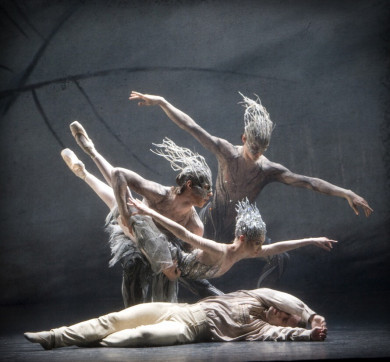Symphony in Three Movements
CREDITS
Music by Igor Stravinsky
Choreography by Radu Poklitaru
Set and Costume Designer: Anna Matison
Lighting Designer: Alexander Sivaev
Video Graphics Designer: Alexander Kravchenko
Assistant Choreographer: Sergei Kon
ABOUT THE PRODUCTION
Using a symphony in ballet is a 20th century innovation. The impulse for the worldwide dissemination of the genre of the dance symphony came with a production by Fyodor Lopukhov in Petrograd in 1923 with a ballet set to the music of Beethoven’s Fourth Symphony. George Balanchine, who took part in that avant-garde production, took up the idea of the plastique interpretation of the complex musical format, developing his artistic credo as a choreographer thus: “You see the music and you hear the dance.” Inspired by the nature of pure dance he rejected any plot and superfluous psychology, behind his movements there were no human passions, there was just the music, its rhythm and structure defining the development of the choreographic image. Following the same lines, in 1972 Balanchine created his first dance version of the score of Stravinsky’s Symphony in Three Movements. And yet there was another path in the emergence of symphonic dance. In the 1930s the choreographer Léonide Massine brought to life a whole series of symphonic ballets in which, avoiding fairy-tale narrative in a sequence of allegories and metaphors he narrated dance stories. The path chosen by Radu Poklitaru for his production of Symphony in Three Movements at the Mariinsky Theatre is close to Massine’s. In his production one can see a plot with a beginning, peripeteia and dénouement. The images conceived by the choreographer blend together with Stravinsky’s idea: the composer admitted that the third movement of his Symphony was a response to documental chronologies of the war years with lines of marching soldiers, and later with Poklitaru, it would seem, the troops come on-stage in the finale, without succumbing to the aggression of the first two movements...
Olga Makarova
Premiere: 30 December 2015, Mariinsky Theatre
Age category 12+
The Fairy's Kiss
CREDITS
Music by Igor Stravinsky
Libretto by the composer after fairy-tales by Hans Christian
Musical Director: Valery Gergiev
Choreographer: Maxim Petrov
Set Designer: Alyona Pikalova
Costume Designer: Uldus Bakhtiozina
Lighting Designer: Konstantin Binkin
Musical Preparation: Lyudmila Sveshnikova
ABOUT THE PRODUCTION
Stravinsky created the ballet Le Baiser de la fée based on Hans Christian Andersen's fairy-tale plot using quotations, motifs and allusions from music by Tchaikovsky and he dedicated the score to the memory of his senior colleague: "Like a fairy, the muse adorned Tchaikovsky with her kiss, the imprint of which is to be observed on every opus by this great artist." Looking for just such a fairy (or muse) is hero of Maxim Petrov's production. In his reading of Stravinsky's opus the choreographer has discarded the peripheral details of the original fairy-tale libretto: no child is stolen and there is no fatal substitution of the bride at the wedding. His male protagonist saves himself from wintry probation dressed in a fashionable down jacket and carrying a mobile phone. And, unlike with Stravinsky there are four fairies, not just one, in this story. Moreover, the beauty of the duet with one of them is not at all an indicator that the protagonist's search is to be crowned with success, and he meets the one who possesses the secret of creation. Which of the fairies is to be the guide in a "land beyond time and space", revealing to the one who has been kissed — a country, with the universal image of which the composer chose to conclude his ballet?
The Fairy's Kiss (under the title Le Baiser de la fée) staged by Bronislava Nijinska: 27 November 1928, The Ida Rubinstein Ballet Company, Paris
Premiere at the Mariinsky Theatre: 11 July 2021
Running time 45 minutes
Age category 12+
Pulcinella
CREDITS
Ballet with Song in One Act
Music by Igor Stravinsky
Choreography and Set Design by Ilya Zhivoi
Costumes Designer: Sofia Vartanian
Lighting Designer: Konstantin Binkin
ABOUT THE PRODUCTION
Pulcinella is a witty and jokester character of commedia dell'arte. Sergei Diaghilev granted this eccentric comedian a permanent residence at the music theatre. It was according to his request that Igor Stravinsky carried out his first discovery of the past and composed a score about the tricks of the commedia dell'arte character based on the music of Pergolesi and other composers of the 18th century. Stravinsky arranged the old music with his harmonies, but he said with modesty that “the remarkable thing about Pulcinella is not how much but how little has been added or changed.” For the choreographer Ilya Zhivoy, who presented his Pulcinella as a part of The creative workshop of the young choreographers, it was the music that determined the staging of this ballet. “Music in Pulcinella struck me as drastically different from Stravinsky’s other works (and I have heard almost all of his music written for theatre). – Ilya Zhivoi said. – I dreamt of staging a narrative ballet — and I did not have any prior experience of working with a piece of literature, with characters and personalities, — but I read the libretto of Pulcinella only after I had been inspired tov stage a production by the music.” The choreographer characterized his idea: “I really wanted to stage an airy, cheerful, and colourful ballet, which you can come to see with your family to have a good laugh.”
Performances of the work are given by permission of Boosey & Hawkes Music Publishers Limited
Premiere of Igor Stravinsky's ballet choreographed by Léonide Massine – 15 May 1920, Ballets Russes de Serge Diaghilev, Grand Opéra, Paris
Premiere of the ballet choreographed by Ilya Zhivoi – 11 July 2018, Mariinsky-II
Running time 40 minutes
Age category 6+
 Mariinsky Theatre:
Mariinsky Theatre:  Mariinsky-2 (New Theatre):
Mariinsky-2 (New Theatre):  Mariinsky Concert Hall:
Mariinsky Concert Hall: 

